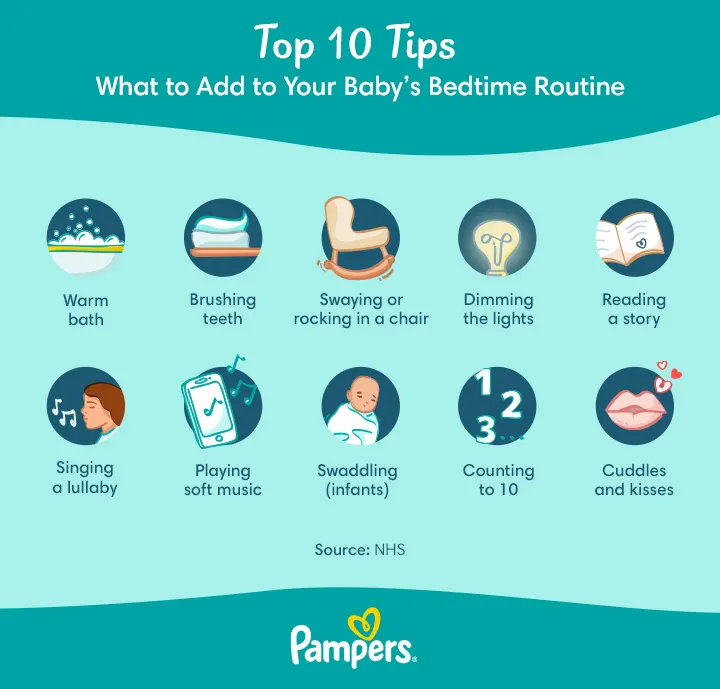
How to Get a Baby to Sleep: 9 Tips and Tricks
There is a common parenting predicament all parents have to deal with: how to get a baby to sleep at night, and fast? Or getting a sleeping baby or newborn to sleep through the night? It’s not uncommon for babies to be wakeful or seemingly full of energy at bedtime, which can make it tricky to get them to settle down and sleep. This struggle to fall asleep can be due to anything from hunger or a wet nappy, to growing pains or illness. It may not always be easy to pinpoint exactly why your baby is wakeful or fussy, but we’ve compiled some tips and tricks that can help you encourage your baby to fall asleep.
9 Tips and Tricks: How to Get a Baby to Sleep
If you’re trying to master how to put a newborn or older baby to sleep, it's helpful to adopt a few strategies that encourage snoozing and soothe crying. We’ve rounded up nine tips and tricks that can help in putting your newborn or older baby to sleep – and using them consistently over time may help your little one learn how to settle down as bedtime (or naptime) approaches. You might even be able to get your baby to sleep in 40 seconds or less (no promises though!) You’ll find our favourite tips in the following paragraphs, so continue reading to learn about them all. Or, if one sparks your interest first, click on the title below to jump to its description.
1. Keep Your Baby Comfortable
Before putting your baby in the cot, check that they’re comfortable. Does your little one need a nappy change or a feeding? Is your baby dressed in appropriate layers for warmth, but not overdressed? Is the room temperature cool but comfortable? A quiet, cosy and calm environment will go a long way in helping your baby fall asleep. A few other ways to keep your baby comfortable and soothed while falling asleep (and, hopefully, staying asleep) include the following:
2. Swaddle Your Baby
If you’re wondering how to put a newborn to sleep, you may wish to try the swaddling method. Experts are divided on the benefits of swaddling, but when done correctly, it may help newborns and young infants fall asleep faster and stay asleep longer. Because their little bodies are still developing, newborns lack motor control and often involuntarily twitch, flail their arms, and move their legs during sleep. This unintentional movement can accidentally wake them, which is why swaddling can be a good solution, as it gives them a feeling of comfort and security and keeps their arms and legs from moving too much. If you decide to swaddle your baby, it’s important to follow the safety guidelines below:
If you’re unsure about swaddling, talk to your little one’s doctor or health visitor for advice.
3. Establish a Sleep Schedule
According to some experts, at around 3 months is a good time to establish a sleep schedule, but keep in mind that it may be many more months before your baby can actually follow it regularly. It’s helpful to anticipate sleep regression as your little one grows and develops, and to remember that sleep training is not a linear process! However, babies tend to love consistency and routine, so sticking as best as you can to a schedule can do wonders for helping your older baby feel sleepy as bedtime or naptime rolls around.
Newborn sleep is a little different⎯it’s quite all over the place (literally and figuratively!), so trying to establish a consistent schedule early on may be futile. But once your little one is ready, you can start sleep training by putting them down in the cot for naps and bedtime when slightly groggy but still awake. The more practice your baby gets sleeping in the cot (as opposed to falling asleep in your arms, for example), the easier it is to establish a schedule. Tracking your baby’s sleep to see what patterns emerge can also help you establish a predictable schedule. Apps like the Smart Sleep Coach by Pampers make light work of this thanks to their developmentally appropriate, AI-powered scheduling tool. All you do is track your baby’s sleep times and the app does the hard work for you, creating a schedule that is in line with your baby's biological sleep rhythms. It will notify you every time your baby is ready to go to sleep. If you think your baby's schedule could use a boost, take this FREE sleep assessment, and learn more about how the Smart Sleep Coach could help your baby fall asleep faster and stay asleep longer!
4. Give Your Baby Attention During the Day
Experts say that your baby will feel calmer and more secure (and ready for sleep in the evening) when you provide them with a good amount of attention and stimulation during the day. Go ahead and hold your little one, cuddle them, play with them and talk to them. Your baby may be more likely to settle down for sleep once they’ve gotten their fill of love and attention while awake. However, don't shower your baby with attention during those middle-of-the-night feedings and nappy changes. Keep these necessary interactions quiet, brief and ‘boring’ so that your little one learns to associate the night with sleep and the day with activity and excitement.
5. Establish a Bedtime Routine
As early as 3 months old, you may wish to create a soothing bedtime routine with your little one. Your routine can include anything you like, but keep the following in mind:
The point of a bedtime routine is to wind down and signal to your baby that the time for sleep is coming. Here’s a list of some things you could include in your baby’s bedtime routine:
6. Place Your Baby in their Cot Before They Fall Asleep
When learning how to put a baby to sleep, this tip is one of the most important. By putting your baby in their cot before they fall asleep (and while sleepy), you can help them form a positive sleep association, equating the cot with snoozes. If your baby always falls asleep in your arms, they may struggle to sleep in the cot, as that won’t feel familiar. It may also result in your baby waking up during the night in their cot and realising they’re no longer in your arms – resulting in them crying out for you. To know when it’s time to put your baby in the cot, look out for sleep cues, such as
If you’re wondering how to put your newborn to sleep safely, remember to practice safe sleep for babies by always placing your little one on their back when you put them down in the cot for napping or sleeping. Also, make sure that their cot is free of loose bedding, blankets, pillows and toys. These precautions may help reduce the risk of Sudden Infant Death Syndrome (SIDS).
7. Offer Your Baby a Dummy
Some people find that giving their little one a dummy at night may help soothe and calm their baby. If you’re breastfeeding, wait until your baby is about 3 to 4 weeks old (when breastfeeding is commonly established) before offering a dummy. If your baby’s dummy falls out while sleeping, there’s no need to put it back in their mouth.
8. Work With Your Baby’s Preferences
work best. Consider adjusting to your baby’s sleep schedule to take advantage of those periods when they naturally feel sleepier. This gives your little one the opportunity to sleep when they want to but doesn’t force sleep when they’re not tired and more likely to protest.
9. Strike a Balance When Attending to Your Baby’s Needs at Night
If your baby is particularly fussy at night and wakes up after falling asleep, try not to go to their side immediately. Instead, give your little one a chance to self-soothe and fall back asleep on their own. The Ferber Method is a well-known sleep training strategy that involves this approach.
But if your baby continues to cry and fuss, they may have a need that should be addressed, such as a feeding or nappy change. When attending to your baby’s needs at night, it’s best to do so without turning on the bedroom lights and while keeping things quiet and calm. After you’re done with the feeding or nappy change, put your baby back in the cot for sleep. If you think your baby is fussy because they may be sick, check for a fever or any other symptoms of illness, and contact your child’s GP as needed.
How to Put a Baby to Sleep: What Not to Do
Now that you have a few tips and tricks to help you understand how to put your newborn or older baby to sleep, it’s also important to consider what not to do. Here are a few things to avoid when putting your newborn or baby to sleep:
FAQs at a Glance
During the first few weeks of life, babies tend to sleep for just one to four hours each time, and each baby has their own sleep pattern. They’re actually rather light sleepers, and wake much more easily than an older child or adult might.
If your newborn is having trouble falling asleep at night, you can help them settle down by following a calming bedtime routine, swaddling, offering a dummy and putting them in the cot when they are sleepy but not yet asleep.
The Bottom Line
If you’re learning how to put your baby to sleep, the best piece of advice is to give the process time – every baby is different! Following our tips and tricks may help make the process easier for your little one to fall asleep and settle into a bedtime routine. Consider things like creating a relaxing bedtime routine, noticing your baby’s sleep cues and adjusting the schedule to coincide with that, and giving your little one lots of love, attention and stimulation when awake. These strategies could all help make bedtime go more smoothly. Hang in there. Getting your baby to sleep is a common challenge of parenthood, but soon enough, your baby (and you too, with any luck!) will be sleeping like, well, a baby!
How We Wrote This Article The information in this article is based on the expert advice found in trusted medical and government sources, such as the National Health Service (NHS). You can find a full list of sources used for this article below. The content on this page should not replace professional medical advice. Always consult medical professionals for full diagnosis and treatment.
- Lullaby Trust. Swaddling and Slings.
- NCT. Newborns and Sleep: Routines and Patterns from 0-3 Months
- NCT. Should I Sleep Train my Baby.
- NCT. Swaddling Baby.
- NCT. Tips to Help Your Baby to Sleep.
- NHS. Handy Sleep Guide
- NHS. Helping Your Baby to Sleep.
- NHS. Reduce the Risk of Sudden Infant Death Syndrome (SIDS).
- NHS. Should my Child Have a Dummy?
- NHS. Safer Sleep 0-3 Months.
- NHS. Safer Sleeping Guide for Babies Under 1 Year Old.



